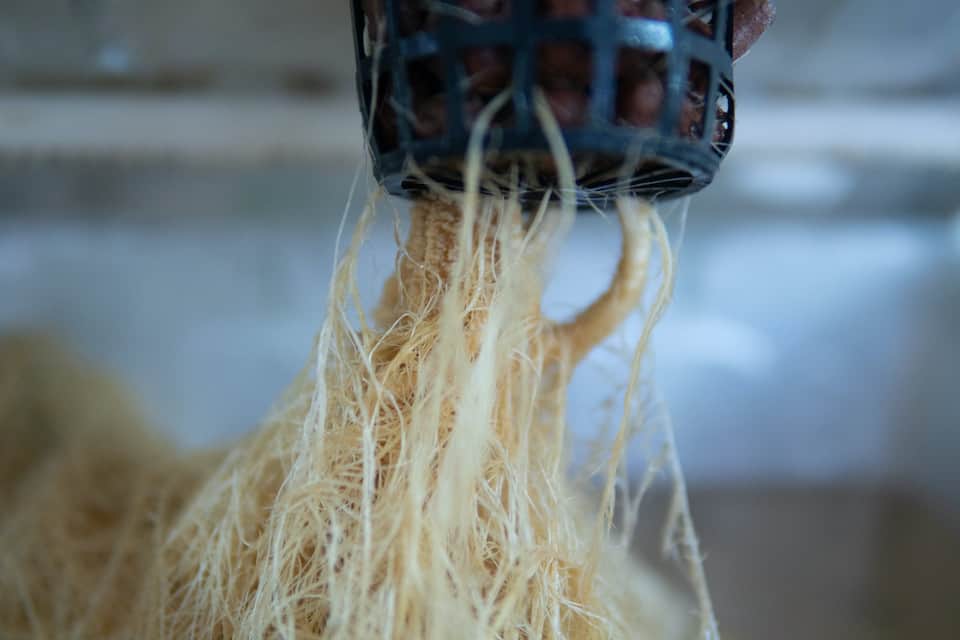TABLE OF CONTENTS
For the best indoor grow system, refer to our dwc hydroponics guide for growers of all skill levels. Deep water culture (DWC) systems are popular types of hydroponic systems that use only water, nutrients, and a growing medium to produce stronger roots and better buds.
Hydroponics, and DWC in particular, is a super effective way to grow weed, but there are many pitfalls. Learn to avoid them all with our DWC hydroponics cannabis grow guide.
What Is Deep Water Culture?
In a DWC system, the cannabis plant’s roots are submerged in a hydroponic nutrient solution/water. The plant's root system is kept in place in a mesh bucket/net pot with hydroton pellets. The plants are usually housed in a self-contained and opaque container such as a bucket (at least 5-gallon).
A major benefit of hydroponic growing is that the plant is being continually watered. However, it's up to you to add the missing macro and micronutrients to give your plants a fighting chance. In addition, you must regulate the pH, dissolved oxygen, and temperature of your solution throughout the plant's life cycle.
What Are Hydroton Clay Pebbles?
Hydroton clay pebbles are derived from an orange-red clay and look like brown balls with black spots. They are pH neutral (inert) and come in a variety of sizes to fit your specific needs. They are also pretty cheap and can be washed, dried, and reused for your next crop.
Hydroton clay pebbles are a good choice due to the clay’s water retention characteristics. Hydroton is capable of absorbing moisture to prevent the roots from drying out, especially in the case of a pump breaking.
In addition, the space between the pellets provides optimal airflow to prevent root rot when there's not enough oxygen. Finally, hydroton exchanges cations (positive ions) with plants to improve nutrient uptake and pH regulation.

Easy DWC Hydroponics Grow Start to Finish Set Up
If you're new to growing cannabis and don't want to build your own system, there are plenty of DWC ready-made systems kits online with everything you need. If you want to go build your own, a DWC system has the following components:
- A light-sealed reservoir to hold the nutrient solution. Usually, a 5-gallon bucket will do, preferably opaque to prevent algae growth. Any cooler or large storage tub can become a reservoir with holes cut out for the baskets and pellets.
- An air pump pushes air volume into the nutrient solution. About one watt per gallon is all you need. Consider hanging the air pump to reduce noise vibrations when placed on a surface.
- An air manifold allows you to attach several diffusers to an air line.
- An air stone (about 4”-6”) pumps air bubbles into the solution and provides enough oxygen to the roots.
- An airline transports the air from the pumps to the air stone. Choose one that is bendable and opaque to prevent algae growth.
- Grow media such as net pots or baskets filled with hydroton clay pellets are excellent for supporting the roots. The net pot will rest on the rim of the bucket, towards the top.
- A water chiller regulates water temperature and keeps temperatures below the level where algae and bacteria can grow.
- A water transfer pump can quickly drain reservoir water.
- Cannabis plants
Cannabis DWC systems range in size. Some growers may place multiple plants in a single reservoir, while others may pump nutrients and oxygen into several small DWC reservoirs that hold one plant each.
To set up your system, fill your reservoir with the properly mixed nutrient solution. In the beginning, when the plants are young, the nutrient solution will reach the bottom of the media.
As the plant grows, the solution level will go down. It's important to check every day to ensure that your plants have the right amount of nutrient solution. Leaving them without any nutrients can quickly damage your roots and plants.
Water/Nutrient Solution For DWC Hydroponics
In the beginning, you won't need to replace the nutrient solution as frequently compared to when the plant has matured. How often you replace the nutrient solution depends. It could be every one to two weeks or longer.
When the plants are young, their roots won't be long enough to reach the bottom of your reservoir. During this initial period of growth, it's important to water your plants from the top.
Advanced top-feeding/dripping systems continuously trickle water over the young plant’s roots. After the plants’ roots have grown enough, some growers switch back to the original DWC set-up.
pH
Invest in a pH meter to regularly check the pH level of your DWC system. Ideally, keep this level between 5.5 to 6.5. If your pH goes beyond this level, consider adjusting the pH using pH kits found online.
Nutrients
We recommend using organic nutrients for the best results. If you're a beginner, consider investing in complete grow systems that include solutions for every stage of growth. Some of the most popular ready-made nutrient options include General Hydroponics’ Flora Grow Series or FoxFarm’s Trio formula.
What Is Recirculating Deep Water Culture?
Recirculating deep water culture is an advanced form of the DWC system. Everything is pretty much the same except for a central main reservoir that connects to multiple bucket distribution lines and the air volume pump that recirculates and aerates the nutrient solution.
This method is particularly effective due to the constant pumping of fresh nutrient solution. In addition, the lateral flow of this system can increase your roots’ health, growth rate, and yield.
“
There are over 300,000 jobs in the cannabis industry. CTU trained me for one of them!

Makes $24.50 @ THC +
Become a Cannabis Grow Expert
If you want to learn about more ways to grow in soil and soilless systems, enroll in Cannabis Training University. CTU offers jam-packed programs on cannabis cultivation, cannabis law, cannabis medicine, cannabis extraction, cannabis cooking, and so much more.
CTU gives you plenty of access time to the course material throughout the growing season and beyond. Become a cannabis growing expert today!

Luis Cordova
Luis Cordova is a distinguished author, and renowned expert in cannabis cultivation, who possesses a Master's degree in Plant Biotechnology and Pharmaceutical Science. As a valued contributor to highly esteemed publications such as Cannabis Training University and Maximum Yield Magazine, Luis has emerged as a trusted source of guidance and knowledge in the cannabis industry. Having written thousands of informative articles, Luis is widely recognized for his comprehensive expertise on cultivating cannabis, both indoors and outdoors.












 Jeff was involved in an accident where he endured a traumatic brain injury. He had a week-long stay in ICU where brain surgeons
Jeff was involved in an accident where he endured a traumatic brain injury. He had a week-long stay in ICU where brain surgeons  100% risk free money back guarantee within 48 hours after purchase if student has not completed any of the courses or exams.
100% risk free money back guarantee within 48 hours after purchase if student has not completed any of the courses or exams.